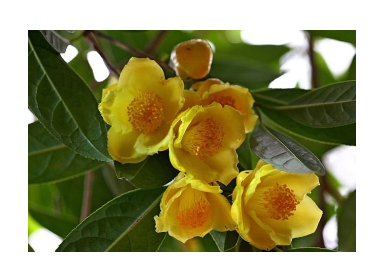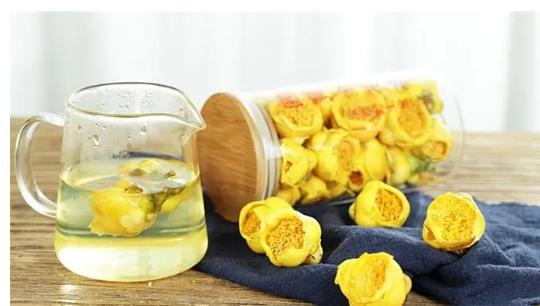At the end of 2023, the National Health Commission approved the use of camellia flowers as a common food ingredient for food development. This has brought the obscure golden tea flowers to the public and become one of the focuses of attention. So what are the flowers of Jinhua tea? What are its health benefits and commercial potential? What kind of product can it be developed into in the future and how will it enter the market? This article will talk about the flowers of Jinhua tea.

01
What are the flowers of Jinhua tea?
Jinhua tea is a precious plant resource belonging to the Camellia genus of the Camellia family, with unique golden petals. It was first discovered in the early 1960s and is mainly distributed in Guangxi Zhuang Autonomous Region, as well as Yunnan and Guizhou. It is one of the first-class protected plants in China. In Guangxi, wild camellia is mainly distributed in Fangchenggang and Nanning. According to the "Current Status and Modern Research Progress of Plant Resources in the Golden Flower Tea Group", the current Golden Flower Tea resources are mainly wild, with an estimated wild resources accounting for over 70%. Traditional applications
Jinhua tea is known as the "Empress of the Tea Clan" and the "Giant Panda of the Plant World". It is a traditional folk medicine of the Zhuang ethnic group in China, and both leaves and flowers can be used for medicinal purposes. The traditional application methods are mainly recorded in relevant medical classics in Guangxi, such as the "Annals of Fusui County". From the perspective of traditional folk applications, the leaves of Jinhua tea are often used as tea drinks in Guangxi, with the main purpose of enhancing physical fitness. The medicinal directions include clearing heat and detoxifying, diuresis and swelling reduction, dysentery, throat, etc. Leaves are often used for throat discomfort, dysentery, etc. Flowers are often used for menstrual disorders, rectal bleeding, and other problems. Ingredients
Through modern research, it has been found that Jinhua tea contains over 400 chemical components, including flavonoids, tea polyphenols, saponins, polysaccharides, as well as proteins, fats, amino acids, minerals, etc. It has certain benefits in clearing free radicals, managing blood sugar, and promoting blood lipid health. Regulatory situation
From a regulatory perspective, in 2010, Jinhua tea was approved by the National Health Commission as a new food ingredient. Therefore, currently, both the leaves and flowers of Jinhua tea can be used as ordinary food ingredients. Standard
It is worth mentioning that Guangxi has introduced relevant standards for Camellia japonica. On June 18, 2021, the Health Commission of Guangxi Zhuang Autonomous Region released the local food safety standard "Golden Camellia" (DBS 45/069-2020). The standard is clear that Camellia sinensis is a product made from fresh flowers of Camellia sinensis (Hu) Tuyama, a plant of the Camellia family and Camellia genus, which is artificially planted. It is processed through processes such as cleaning or not cleaning, picking, cutting or not cutting, killing or not killing, and drying. The specific indicator requirements are as follows: At the same time, the standard puts forward relevant requirements for the inspection, labeling, labeling, packaging, transportation, storage, and shelf life of Camellia japonica. Among them, the pre packaging label should indicate "Not suitable for consumption by infants, pregnant women, and nursing mothers". Process technology
From the perspective of production technology, according to the Research Progress of Jinhua Tea Components and Pharmacological Effects, compared with the physical characteristics of ordinary powder, ultramicro powder and nano powder of Jinhua Tea, ultramicro powder has higher dissolution rate and saponin dissolution, higher bioavailability, and may have better development prospects in the future. This also means that in the future, the mainstream production and processing technology of Jinhua tea flowers may be ultrafine powder.

02
Product development of Jinhua tea flowers
As a widely recognized medicinal and food homologous substance, Jinhua tea has outstanding health value and also has traditional folk customs of application. Therefore, from the perspective of the health attributes of the raw materials, it has good development prospects and value. However, as mentioned earlier, Jinhua tea is currently mainly wild resources, and upstream cultivation and supply will be a major challenge. Artificial planting situation However, the scale of artificially cultivated Camellia sinensis is currently expanding. It is understood that a tree with a tree age of more than 10 years can produce 5 kilograms of fresh flowers, and the yield will increase with the age of the tree. Taking Fangcheng District, one of the main production areas of Jinhua tea, as an example, the planting area of Jinhua tea in this area has reached 186000 acres so far. In 2022, the production of Jinhua tea and fresh flowers in Fangcheng District was 150000 kilograms, with 28800 kilograms of dried flowers and 400 tons of fresh leaves. This is enough to see that there is still a certain amount of supply of flowers and fresh leaves in Jinhua tea at present. From a price perspective, the current price of Jinhua tea has decreased, from tens of thousands per kilogram to thousands of yuan per kilogram. This also provides a certain foundation for Jinhua tea to enter the consumer market. Terminal product development
Specifically for downstream products. At present, the downstream terminal product development of Jinhua tea flowers is still in a relatively primitive state, mainly focused on various types of tea drinks, such as dried flower/freeze-dried flower tea, tea cakes, etc. This is the most mainstream category of Jinhua tea flower products. In addition, there are relatively few other types of products such as Jinhua tea flowers. The brand "Moe Hua You Zhu" has developed a beverage using Jinhua tea flowers - Jinhua Drink. In addition to adding golden camellia flowers to the formula, it is also paired with goji berries, gardenia, osmanthus, licorice, cassia seeds, etc. Our main focus is on health preservation. It can be said that it is an inheritance and upgrade of traditional Jinhua tea drinks. In addition, there are also local foods such as honeysuckle tea mooncakes and honeysuckle tea stewed chicken soup. Overall, due to just being approved, the terminal products of Jinhua tea flowers are still very rare. With the relaxation of regulations, as a beautiful, healthy and high-value raw material, Jinhua tea flowers may show more possibilities and postures in the end market. So where is its potential direction?

03
Where is the future "money" landscape?
At present, nearly 2000 research literature related to Jinhua tea can be searched on domestic CNKI platforms, of which 325 are about the flowers of Jinhua tea. It can be seen that Jinhua tea and its flowers have a certain foundation in scientific research and require continuous improvement. Nutrient composition and content
It is reported that the nutritional content of camellia flowers is as follows: water-soluble sugar (39%), crude fiber (30%), crude protein (5.6%), and crude fat (1.94%); The content of flavonoids in camellia is 8.5%; The content of tea polyphenols is 4.42%; The saponin content is 7%, which is 37 times, 2.1 times, and 1.4 times higher than that of Jinhua tea leaves, respectively. The total free amino acids in flowers are 80.8mg/100g; The content of Vitamin C is 90mg/100g; The content of vitamin E is 520mg/100g. Track positioning
From a health perspective, Jinhua tea flowers can be applied in multiple directions, and there are several directions with great potential. Firstly, oral beauty. Jinhua tea flowers have a good ability to scavenge free radicals. In terms of ABTS+scavenging ability, the effect of flowers is>fruit shell>bud tip>leaves. The raw materials contain polyphenols, flavonoids, and total saponins of camellia flowers, which are all excellent natural components for clearing free radicals. Secondly, weight management. The content of flavonoids in the flowers of Jinhua tea is high, and it has been found through rat experiments that it is also beneficial for weight management. The mechanism of action includes reducing appetite and reducing food intake; Inhibiting the activity of digestive enzymes in the body, reducing food absorption, and promoting the excretion of energy substances in feces. Thirdly, blood sugar/lipid health. Jinhua tea flowers contain high levels of polyphenols and polysaccharides, which have a good performance in blood sugar health. A team in China conducted mouse experiments on the use of Camellia japonica in this direction. The study found that the water extract of Camellia japonica exhibited good performance in aspects such as fasting blood glucose, postprandial blood glucose, total cholesterol, triglycerides, and low-density lipoprotein cholesterol. In the rat experiment, the water extract and alcohol extract of Camellia sinensis also showed good performance in the direction of blood lipids such as TC, TG, and LDL-C. Therefore, in the future, Jinhua tea flowers can also be commercialized in the blood sugar and lipid health markets, and related products can be developed. Fourthly, lung health and respiratory health. The water extract of camellia flowers can also provide good support for lung health and respiratory health. The domestic team has also conducted mouse experiments in this direction. Summary
Overall, Jinhua tea flowers have great potential in multiple health directions. Especially its beautiful appearance, as well as its reputation as the "Tea Queen" and "Botanical Giant Panda", makes this raw material very suitable for oral beauty and other health directions. It is a rare raw material with outstanding health attributes and a story and selling point, and is worth exploring and trying in various aspects of commercialization by enterprises.
Shaanxi Huike Botanical Development Co., Ltd. a integrated enterprise which is focus on natural products, plant extract related products and services.We mainly focus on pharmaceutical, functional food, Freeze-dried powder,Natural Pigment,Homology of medicine and food,beverages and other business services.
For more information about inulin, please contact us!
Email:marketing@huikes.com
2024-05-10
Shaanxi Huike Botanical Development Co., Ltd.





